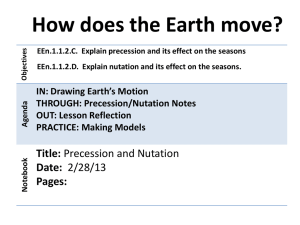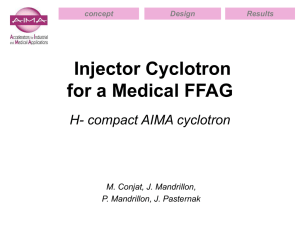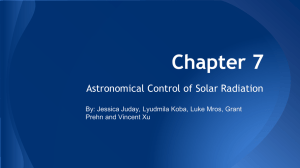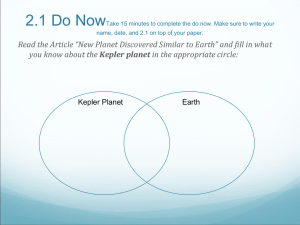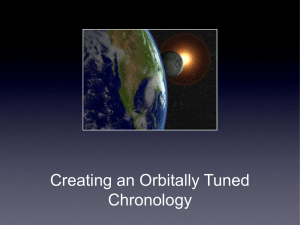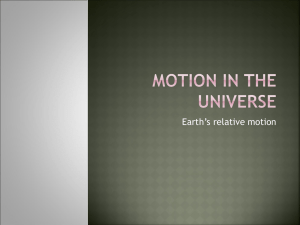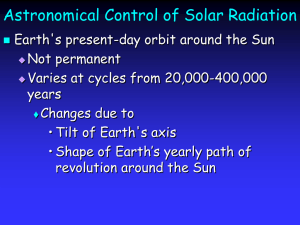Precession Diffraction - Erice Crystallography 2011 IT Support
advertisement
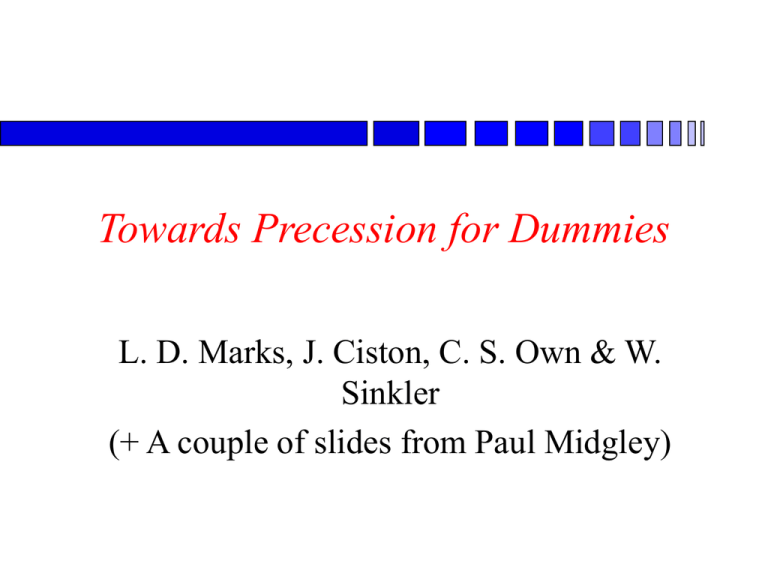
Towards Precession for Dummies
L. D. Marks, J. Ciston, C. S. Own & W.
Sinkler
(+ A couple of slides from Paul Midgley)
Scan
Specimen
Precessed
Non-precessed
De-scan
(Ga,In)2SnO5 Intensities
412Å crystal thickness
Conventional
Precession
Precession…
Diffraction Pattern
(Diffracted
amplitudes)
Precession
System
US patent application:
“A hollow-cone electron diffraction system”.
Application serial number 60/531,641, Dec 2004.
Some Practical Issues
Projector Spiral
Distortions (60 mRad tilt)
Bi-polar push-pull circuit
(H9000)
Block
Diagram
‘Aberrations’
e
Remember the optics
Idealized Diagram
Better Diagram
Postfield Misaligned
Scan
Objective
Prefield
Sample
Objective
Postfield
Descan
Remember the optics
Idealized Diagram
Correct Diagram
Both Misaligned
Scan
Objective
Prefield
Sample
Objective
Postfield
Descan
One Consequence
Prefield/Postfield displacements of beam
dPre = 1/(2p) Pre(s-tPre);
s = Scan
dPost=1/(2p) Post(s-tPost) -sDq sD = DeScan
(u)/(2p) = Dzq+Csq3
Total apparent displacement is the sum
dNett = dPre+dPost
= DzPre(q-qPre)+DzPost(q-qPost)
+ CsPre(q-qPre)3+CsPost(q-qPost)3
-sDq
Probe and Displacements (nm)
Prefield misalignment 1 mRad; Postfield -1.0 mRad
8
Displ on Sample
No Descan
6
Apparent Probe Shift
4
2
0
-10
-8
-6
-4
-2
0
-2
-4
-6
-8
2
4
6
Caveat: this ignores
3-fold astigmatism in
pre/post field which
is probably not
appropriate, and any
projector distortions
Overview
Part I: What is the theory of precession
Early Models
1) Kinematical/Bragg’s Law
2) Blackmann (2-beam all angles)
3) Lorentz corrected Blackmann
More Recent Models
4) 2-beam integrated correctly
Good Models
5) Full Dynamical
Overview
Part II: What, if any generalizations can be
made?
Role of Precession Angle
– Systematic Row Limit
Importance of integration
– Phase insensitivity
– Important for which reflections are used
– Fast Integration Options
Four basic elements are required to
solve a recovery problem
1. A data formation model
Imaging/Diffraction/Measurement
2. A priori information
The presence of atoms or similar
3. A recovery criterion:
A numerical test of Goodness-of-Fit
4. A solution method.
Mathematical details
Patrick Combettes, (1996). Adv. Imag. Elec. Phys. 95, 155
Ewald Sphere
Construction
Scan
Specim
en
Descan
k+s
k
s
(Diffract
ed
amplitud
es)
z
0
sz
g
Levels of theory
Precession integrates each beam over sz
Full dynamical theory
– All reciprocal lattice vectors are coupled and not
seperable
Partial dynamical theory (2-beam)
– Consider each reciprocal lattice vector dynamically
coupled to transmitted beam only
Kinematical theory
– Consider only role of sz assuming weak scattering
Bragg’s Law
– I = |F(g)|2
Some Accuracy Please!
Kinematical Theory is not I=|F(g)|2
This is Bragg’s Law
This is the limit for weak scattering of thick,
perfect crystals
Kinematical Theory includes the Ewald Sphere
curvature
Dynamical Theory also includes multiple
scattering
Please see Cowley, Diffraction Physics
Also, beware of other
approximations
Column Approximation
– Approximate sample of varying thickness as an
average of intensities from different thicknesses
– Correct in the limit of slowly varying sample
thickness
– Perhaps not be correct for PED from
nanoparticles or precipitates
Inelastic/Absorption (needed for thick
samples)
Early Models
Iobs depends upon |F(g)|, g, f (precession
angle) which we “correct” to the true result
Options:
0) No correction at all, I=|F(g)|2
1) Geometry only (Lorentz, by analogy to xray diffraction) corresponds to angular
integration
2) Geometry plus multiplicative term for |F(g)|
Bragg’s Law fails badly (Ga,In)2SnO5
GITO [010] Precession intensities, 50 A
GITO [010] Precession intensities, 3.2 A
GITO [010] Precession intensities, 100 A
0.10
0.0004
3.2 Å; R=0.02
0.06
100 Å; R=0.25
50 Å; R=0.19
0.08
Kinematical intensity
Kinematical intensity
0.0002
0.04
0.06
0.04
0.02
0.0001
0.02
0.0000
0.0000
0.0001
0.0002
0.0003
0.0004
0.00
0.000
0.005
0.010
Multislice intensity
0.015
0.020
0.025
0.030
0.00
0.000
0.005
Multislice intensity
0.010
0.015
0.020
Multislice intensity
GITO [010] Precession intensities, 800 A
GITO [010] Precession intensities, 400 A
GITO [010] Precession intensities, 200 A
10
2.5
0.6
800 Å; R=0.88
400 Å*; R=0.78
200 Å; R=0.49
8
0.4
Kinematical intensity
Kinematical intensity
2.0
Kinematical intensity
Kinematical intensity
0.0003
1.5
1.0
6
4
0.2
2
0.5
0.0
0.000
0.005
0.010
0.015
0.020
Multislice intensity
0.025
0.030
0.0
0.000
0
0.000
0.002
0.004
0.006
0.008
0.010
0.012
Multislice intensity
0.014
0.016
0.002
0.004
0.006
0.018
Multislice intensity
0.008
0.010
Kinematical Lorentz Correction
I(g) = |F(g) sin(ptsz)/(psz) |2 dsz
sz taken appropriately over the Precession Circuit
t is crystal thickness (column approximation)
f is total precession angle
2
I(g) = |F(g)|2L(g,t,f) Lg , t , f = g 1 - g
2R
0
K. Gjønnes, Ultramicroscopy, 1997.
Kinematical Lorentz correction:
Fcorr
Geometry information is insufficient
Fkin
Need structure factors to apply the correction!
2-Beam (Blackman) form
I Blackman t =
Limits:
Ag
J 2 x dx;
0
Ag (k ) tF (k )
0
Ag small; Idyn(k) Ikin(k)
Ag large; Idyn(k) Ikin(k) = |Fkin(k)|
But…
This assumes integration over all angles,
which is not correct for precession (correct
for powder diffraction)
Blackman Form
Blackman+Lorentz
Comparison with full calculation, 24 mRad
R1
0.8
0.7
0.6
0.5
0.4
0.3
0.2
0.1
0
0
200
400
600
Thickness Angstroms
Alas, little better than kinematical
800
1000
Two-Beam Form
I(g) = | F(g) sin(ptseffz)/(pseffz) |2 dsz
sz taken appropriately over the Precession Circuit
szeff = (sz2 + 1/xg2)1/2
pVc cosq B
xg =
Fg
Do the proper integration over sz (not rocket science)
Two-Beam Integration: Ewald Sphere
3
2
1
0.08
0
0.06
Small (hkl)
sz/x g
0.04
-1
0.02
-2
Scan Angle
0
-3
0
-0.02
45
90
135
180
225
270
315
360
270
315
360
-0.04
-0.06
Medium (hkl)
1.5
Large (hkl)
12
sz /x g
sz/x g
10
1
8
0.5
6
Scan Angle
0
0
45
90
135
180
225
270
315
360
4
-0.5
2
-1
0
Scan Angle
0
45
90
135
180
225
2-Beam Integration better
0.07
a) 3.2 Å, R=0.023.
3.2 Å; R=0.02
0.0003
c) 100 Å, R=0.236
b) 50 Å, R=0.186
0.04
50 Å; R=0.19
0.06
100 Å;R=0.24
0.05
2-beam intensities
2-beam intensities
0.0002
0.02
0.04
0.03
0.02
0.0001
0.01
0.01
0.0000
0.0000
0.0001
0.0002
0.00
0.000
0.0003
0.005
0.010
Multislice intensities
0.10
d) 200 Å, R=0.444
0.10
0.015
0.020
0.00
0.00
0.025
0.01
0.03
0.04
0.006
0.008
0.10
e) 400 Å, R=0.626
f) 800Å, R=0.672
800 Å; R=0.67
400 Å*; R=0.62
200 Å; R=0.44
0.02
Multislice intensities
Multislice intensities
0.12
0.08
0.08
0.06
2-beam intensities
2-beam intensities
0.08
2-beam intensities
2-beam intensities
0.03
0.06
0.04
0.06
0.04
0.04
0.00
0.000
0.02
0.02
0.02
0.005
0.010
0.015
0.020
Multislice intensities
0.025
0.030
0.00
0.000
0.002
0.004
0.006
0.008
Multislice intensities
0.010
0.012
0.014
0.00
0.000
0.002
0.004
Multislice intensities
Some numbers
1.0
1.0
R-factors for kinematical model
0.8
0.8
0.6
0.6
R-factor
R-factor
R-factors for 2-beam model
0.4
12 mrad
24 mrad
36 mrad
48 mrad
60 mrad
72 mrad
0.4
12 mrad
24 mrad
36 mrad
48 mrad
60 mrad
72 mrad
0.2
0.2
0.0
0.0
0
200
400
600
Thickness [A]
800
1000
0
200
400
600
800
1000
Thickness [A]
See Sinkler, Own and Marks, Ultramic. 107 (2007)
Fully Dynamical: Multislice
“Conventional” multislice (NUMIS code, on cvs)
Integrate over different incident directions
2f
100-1000 tilts
f = cone semi-angle
t
– 0 – 50 mrad typical
t = thickness
– ~20 – 50 nm typical
– Explore: 4 – 150 nm
g = reflection vector
– |g| = 0.25 – 1 Å-1 are structure-defining
Multislice Simulation
Multislice simulations carried
out using 1000 discrete tilts
(8 shown) incoherently
summed to produce the
precession pattern1
How to treat scattering?
1) Doyle-Turner (atomistic)
2) Full charge density string
potential -- later
1
C.S. Own, W. Sinkler, L.D. Marks Acta Cryst A62 434 (2006)
Multislice Simulation: works (of course)
R1 ~10% without
refinement of anything
Global error metric: R1
R-factor, (Ga,In)2SnO4
0.8
0.7
exp
sim
exp
R-factor
R1
F -F
=
F
0.6
0.5
0.4
0.3
0.2
On Zone
0.1
Precession
0
0
250
500
750
1000
1250
1500
t (Å)
Broad clear global minimum – atom positions fixed
R-factor = 11.8% (experiment matches simulated known structure)
– Compared to >30% from previous precession studies
Accurate thickness determination:
– Average t ~ 41nm (very thick crystal for studying this material)
(Own, Sinkler, & Marks, in preparation.)
Quantitative Benchmark:
Multislice Simulation
Absolute Error = simulation(t) - Bragg’s
kinematical
Law
Error
thickness
g
75mrad
24mrad
10mrad
50mrad
0mrad
Experimental dataset
(Own, Sinkler, & Marks, in preparation.)
Partial Conclusions
Separable corrections fail; doing nothing is
normally better
Two-beam correction is not bad (not
wonderful)
Only correct model is full dynamical one
(alas)
N.B., Other models, e.g. channelling, so far
fail badly – the “right” approximation has
not been found
Overview
Part II: What, if any generalizations can be
made?
Role of Precession Angle
– Systematic Row Limit
Importance of integration
– Phase insensitivity
– Important for which reflections are used
Role of Angle: Andalusite
Natural Mineral
– Al2SiO5
– Orthorhombic (Pnnm)
» a=7.7942
» b=7.8985
» c=5.559
– 32 atoms/unit cell
Sample Prep
– Crush
– Disperse on holey
carbon film
– Random Orientation
2 C.W.Burnham, Z. Krystall. 115, 269-290, 1961
Measured and Simulated Precession
patterns
Bragg’s Law Simulation
Experimental
Multislice
Precession
6.5
13 mrad
18
24
32
mradOff
Decay of Forbidden Reflections
Decay with increasing
precession angle is
exponential
– The non-forbidden (002)
reflections decays linearly
I = A exp(- Df )
D(001)
D(003)
0.109
R2=0.991
0.145
R2=0.999
Simulated
(102nm)
0.112
R2=0.986
0.139
R2=0.963
Simulated
28-126 nm
0.112±0.012
0.164±0.015
Experimental
Rate of decay is relatively
invariant of the crystal thickness
Slightly different from Jean-Paul’s
& Paul’s – different case
Quasi-systematic row
Precessed
On-Zone
Precession
Systematic
Row
Forbidden, Allowed by Double Diffraction
Evidence: 2g allowed
Si [110]
Si [112]
Rows of reflections arrowed should be absent (Fhkl = 0)
Reflections still present along strong systematic rows
Known breakdown of Blackman model
e
Phase and Averaging
For each of the incident condition generate 50 random
phase sets {f} and calculate patterns:
Single settings at 0, 12, 24 and 36 mrad
(along arbitrary tilt direction).
+
0 mrad
+
12
+
24
+
+
+ 36
+
+
At fixed semi-angle (36 mrad) average over
range of a as follows:
3 settings at intervals of 0.35º
5 settings at intervals of 0.35º
21 settings at intervals of 1º
For each g and thickness compute avg., stdev:
1
2
1
2
(
g
,
t
)
=
I
(
g
,
t
)
I
(
g
,
t
)
I (g , t ) = I (g , t )
50
50 { }
{ }
1
2
Phase independence when averaged
Single setting calculations
Multiple settings calculations at f=36 mrad
1.2
1.0
Average of relative standard deviation
Average of relative standard deviation
1.2
0.8
0.6
0.4
1 setting, 0 mrad
1 setting, 12 mrad
1 setting, 24 mrad
1 setting, 36 mrad
0.2
0.0
single setting
1.0
3 settings,
0.35º interval
0.8
5 settings,
0.35º interval
0.6
0.4
21 settings,
1º interval
(approaching
precession)
0.2
0.0
0
500
1000
Thickness [A]
1500
2000
0
500
1000
Thickness [A]
Sinkler & Marks, 2009
1500
2000
Why does it work?
If the experimental Patterson Map is similar
to the Bragg’s Law Patterson Map, the
structure is solvable – Doug Dorset
If the deviations from Bragg’s Law are
statistical and “small enough” the structure
is solvable – LDM
Why is works - Intensity mapping
Iff Iobs(k1)>Iobs(k2) when Fkin(k1) > Fkin(k2)
– Structure should be invertible (symbolic logic,
triplets, flipping…)
I observed
F kinematical
Speculation…Full Method
Generate initial structure estimate
– Intial Bragg’s Law Analysis or part of data
Two-Beam Integration: Ewald Sphere
3
2
1
0.08
0
0.06
Small (hkl)
sz/x g
0.04
-1
0.02
-2
Scan Angle
0
-3
0
-0.02
45
90
135
180
225
270
315
360
270
315
360
-0.04
-0.06
Medium (hkl)
1.5
Large (hkl)
12
sz /x g
sz/x g
10
1
8
0.5
6
Scan Angle
0
0
45
90
135
180
225
270
315
360
4
-0.5
2
-1
0
Scan Angle
0
45
90
135
180
225
Preprocess?
“Good” Region
Bragg’s Law (reference)
Precession pattern (experiment)
f = 24mrad
Speculation…Full Method
Generate initial structure estimate
– Intial Bragg’s Law Analysis or part of data
– Use 2-beam approximation to invert/correct
– Partial refinement, using 1/2 kpoint BlochWave method
Approximation of precession circuit by series
of g-vector tilts:
First approximation; single eigen-solution
g-vector tilts obtained from
2nd approximation; two eigen-solutions
g-vector tilts obtained from
=> increasingly accurate precession calculation
Precession calculations for (Ga,In)2SnO5, 36 mrad
semi-angle, increasing numbers of eigensolutions.
R-Factor agreement between exact precession circuit
(1024 settings) and approximation using increasing numbers
of Bloch calculations in 1st Brillouin Zone
0.012
From S-matrix columns, single Eigenvalue calc.
0.35
0.30
0.25
2
R-Factor
1
0.20
4
0.15
0.10
8
0.05
0.00
0
500
1000
Thickness [A]
1500
2000
0.010
0.008
0.006
0.004
0.002
0.000
0.000
0.002
0.004
0.006
0.008
Bloch, exact precession circuit
0.010
0.012
Speculation…Full Method
Generate initial structure estimate
– Intial Bragg’s Law Analysis or part of data
– Use 2-beam approximation to invert/correct
– Partial refinement, using 1/2 kpoint BlochWave method
– Final full refinement using 25-100 beam BW
(+Bethe terms, e.g. Stadleman or NUMIS +
dmnf, large residual code)
Hypothesis: Thickness ranges
Bragg’s Law
(not so easy)
(pseudo-Bragg’s Law)
Summary
PED is
–
–
–
–
Approximately Invertable
Pseudo Bragg’s Law
Approximately 2-beam, but not great
Properly Explained by Dynamical Theory
PED is not
– Pseudo-Kinematical (this is different!)
– Fully Understood by Dummies, yet
Questions?
